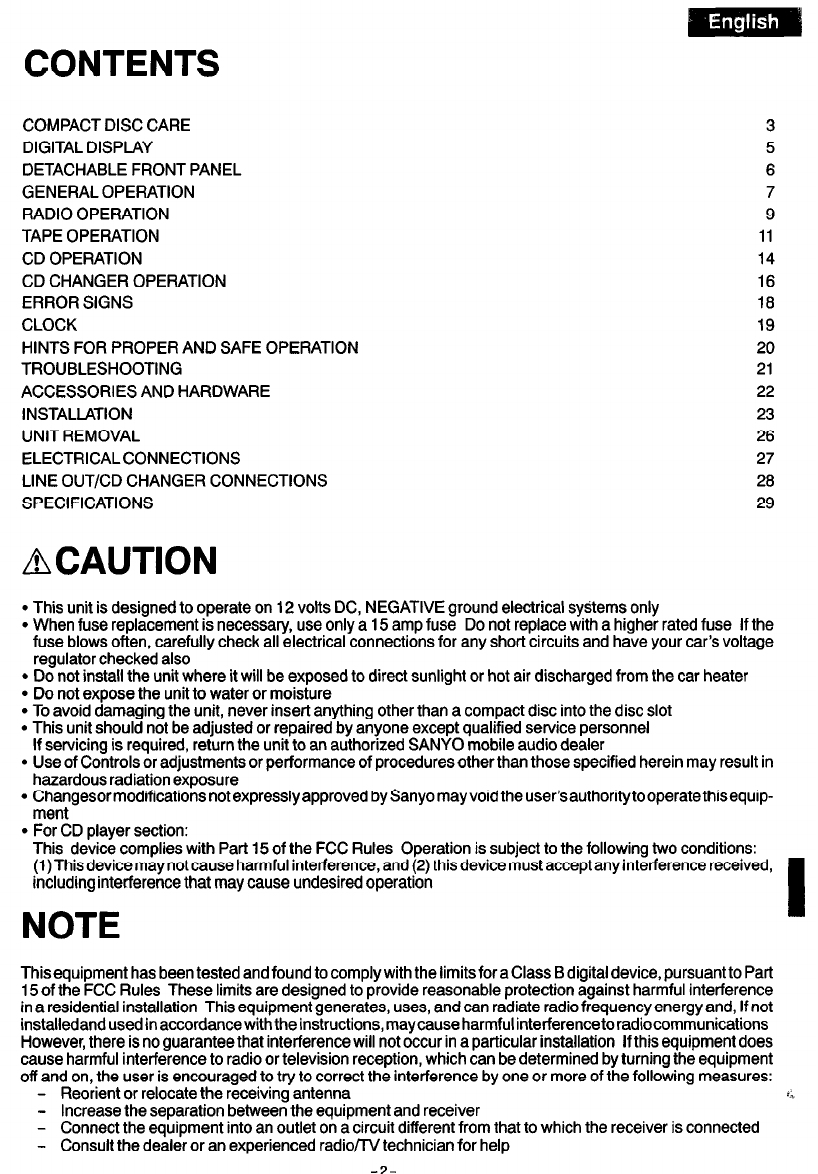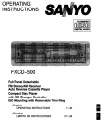
CONTENTS
COMPACT DISC CARE 3
DIGITAL DISPLAY 5
DETACHABLE FRONT PANEL 6
GENERAL OPERATION 7
RADIO OPERATION 9
TAPE OPERATION 11
CD OPERATION 14
CD CHANGER OPERATION 16
ERROR SIGNS 16
CLOCK 19
HINTS FOR PROPER AND SAFE OPERATION 20
TROUBLESHOOTING 21
ACCESSORIES AND HARDWARE
22
INSTALLATION 23
UNIT REMOVAL 26
ELECTRICALCONNECTIONS 27
LINE OUT/CD CHANGER CONNECTIONS 26
SPECIFICATIONS 29
ACAUTION
l
This unit is designed to operate on 12 volts DC, NEGATIVE ground electrical systems only
l
When fuse replacement is necessary, use only a 15 amp fuse Do not replace with a higher rated fuse If the
fuse blows often, carefully check all electrical connections for any short circuits and have your car’s voltage
regulator checked also
l
Do not install the unit where it will be exposed to direct sunlight or hot air discharged from the car heater
l
Do not expose the unit to water or moisture
l
To avoid damaging the unit, never insert anything other than a compact disc into the disc slot
l
This unit should not be adjusted or repaired by anyone except qualified service personnel
If servicing is required, return the unit to an authorized SANYO mobile audio dealer
l
Use of Controls or adjustments or performance of procedures other than those specified herein may result in
hazardous radiation exposure
l
Changesormodifications notexpresslyapproved by Sanyo mayvoidthe user’sauthoritytooperatethisequip-
ment
l
For CD player section:
This device complies with Part 15 of the FCC Rutes Operation is subject to the following two conditions:
(1) This device may not cause harmful interference, and (2) this device must accept any interference received,
including interference that may cause undesired operation
NOTE
I
Thisequipment has been tested and found to comply with the limits for a Class B digital device, pursuant to Part
15 of the FCC Rules These limits are designed to provide reasonable protection against harmful interference
in a residential installation This equipment generates, uses, and can radiate radio frequency energy and, If not
installedand used inaccordancewiththeinstructions, maycauseharmfulinterferencetoradiocommunications
However, there is no guarantee that interference will not occur in a particular installation If this equipment does
cause harmful interference to radio or television reception, which can be determined by turning the equipment
off and on, the user is encouraged to try to correct the interference by one or more of the following measures:
- Reorient or relocate the receiving antenna
- Increase the separation between the equipment and receiver
- Connect the equipment into an outlet on a circuit different from that to which the receiver is connected
- Consult the dealer or an experienced radiom technician for help
-2-


















